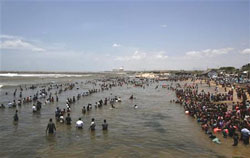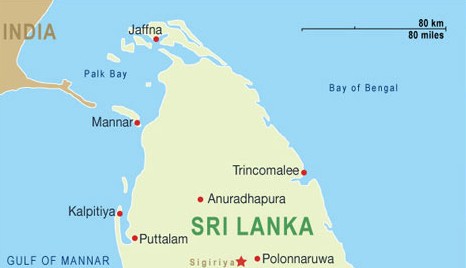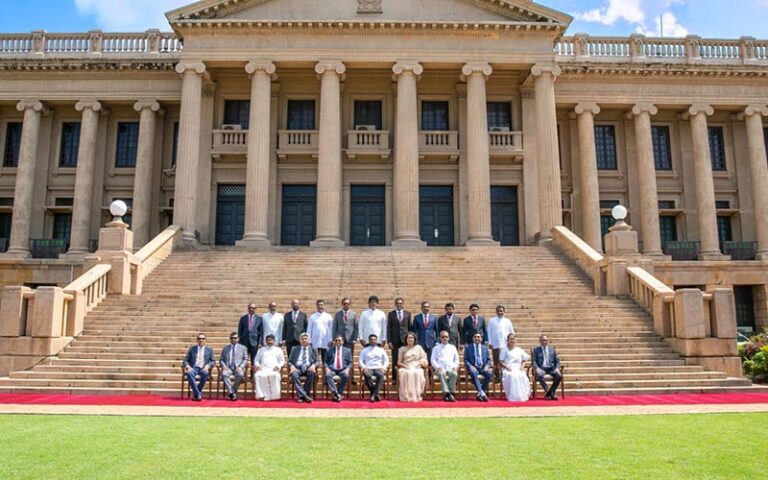
The Indian Government’s plans to expand its nuclear energy programme by establishing 48 new reactors throughout the sub-continent, more than double of what it has, is already causing ripples within that country. It will also be cause for concern for Sri Lanka whose population is less than 160 kms from India’s southern-most plant at Kudankulam and not too far away from the Kalpakkam plant. For reasons best known to the Sri Lankan Government, there is hardly a murmur of protest about the impending dangers of a fallout from a nuclear disaster at either of these plants.
The Power & Energy Minister is a pro-nuclear energy politician who speaks of “vast opportunities” from exploiting nuclear energy. He speaks of benefits that will accrue to agriculture, power generation, medicine etc., and advocates its use in Sri Lanka as well. Whether this is government policy is unclear in the absence of any definitive statement, but even the minister admitted in Parliament this week that India has not given Sri Lanka its ‘safety analysis report’ on the twin nuclear reactors and conceded that “there was no 100% guarantee that an accident would not happen”.
The Environment Ministry is ominously silent on the issue as is the External Affairs Ministry which has surrendered Indo-Lanka relations to the President’s Office. The ball is largely with the officials from the Atomic Energy Authority and a few environmentalists ringing alarm bells – so far to no avail.
The use of nuclear power for peaceful purposes is still a widely debated and debatable issue throughout the world. The debate began back in the 1980s after the disaster in Chernobyl in the former Soviet Union region of Ukraine. The explosion at one of the reactors there wiped out villages in a 50-mile radius and the winds took the ill-effects to neighbouring countries in Eastern Europe 200 kilometres away. The nuclear programmes, however, continued until last year, when the Fukushima nuclear plant in Japan was destroyed by a tsunami.
If Chernobyl was a man-made disaster, Fukushima was a natural disaster. Either way they were disasters that had devastating impacts on humankind. The latter incident re-opened the debate and while countries like Germany and Japan, announced a phasing-out of nuclear energy due largely to the dangers and risks involved, others like China and India, searching for new sources of energy for growing industry and a rising middle class looking for cheap electricity, are going ahead with nuclear energy. But that is a separate argument. In an editorial on August 14 last year under the heading “Sound the alarm on Nuclear issue” (www.sundaytimes.lk/Editorial archives) we discussed this issue. We pointed out to the Cancer Hospital authorities in Maharagama complaining that the Pradeshiya Sabha in the area was unable to clear radioactive waste. How can we then deal with much bigger nuclear waste issues? What is our preparedness for a nuclear clean-up; do our soldiers have the necessary uniforms; do we have special units in hospitals. What about skin ailments, and deformities in unborn children? Have we asked ourselves these questions.
The ever alert Indian Supreme Court, which keeps a check on the Indian Government has now stepped in to question the developers of the Indian plants as to how the nuclear waste is going to be stored, transported and disposed of without having the environment and the health of the local populace in the plant’s vicinity exposed to danger. Several Indian activist groups are being heard by the Supreme Court even though the Tamil Nadu Chief Minister, Jayaram Jayalalithaa, first opposed and then somersaulted to support the commissioning of these plants in her state.
Sri Lanka went into talks with the Indians at an official level raising concerns, but as this newspaper has pointed out over the past fortnight, only assurances and early warning systems were forthcoming from across the Palk Straits. What can be done even after an early warning system alerts the local populace no one knows. For good measure India even offered compensation if things were to go awry. This reminds one of the British firm that was awarded a controversial tender to provide bulletproof vests for our fighting soldiers saying they would provide compensation if their vests couldn’t stop a bullet.
Why the nuclear fallout issue cannot be elevated to a political level remains an unanswered question, and it could be seen as the Government in Colombo being too timid to pitch it at a higher level. Back in August last year we asked the same question. In the inter-connected world in which we live, a nuclear disaster in south India can have its repercussions on Sri Lankan citizens. Needless to say, it is the duty of the State to ensure their safety and security, and to speak up on their behalf when the need arises, as it has now. It is still better late than never.
Politics of human rights
Come next week, Sri Lanka goes before the UN Human Rights Council in Geneva once again. Global human rights activists are howling like ravenous wolves calling for a cleaner slate from Sri Lanka. The UPR is applicable to all the member-states of the UN organisation, but the fact that international politics plays a huge role in its implementation is an open secret. For the record, even the US and Britain have to justify their human rights records before the bar of the UNHRC; but there’s some truth when Sri Lanka’s External Affairs Minister goes before the UN General Assembly as he did last month, and complains that there is a selective targeting of some countries at the world forum.
The UN Secretary General Ban Ki-moon says the UPR system that was put into place in 2006 to monitor each country’s human rights records “has great potential to promote and protect human rights in the darkest corners of the world”. One can only hope that Sri Lanka does not come under that classification of places on this globe.� It was indeed one of the ‘darkest corners of the world’ for many years until the Liberation Tigers of Tamil Eelam (LTTE) was militarily vanquished in 2009. The last UPR was back in 2008 when Sri Lanka gave certain undertakings to clean up its somewhat questionable human rights record at the time. There was a full-scale guerrilla war on then and much leeway was afforded to the Government of the day to squash that rebellion at the expense of certain internationally benchmarked human rights standards. It is three years since the end of that bloody, debilitating insurgency, and the Government by now ought to have put in place at least the markings on the roadway to a better human rights record.
Unfortunately, the UNHRC in Geneva has become the playground of international politics and the substantive issue of human rights has become a secondary issue. The whole purpose of the UPR, however, ought not to be merely to take stock of the situation or to meet the arguments thrown at the country and come away unscathed so that one can fight another day, but to ensure that the citizens of a country receive better from the Government that represents them.




